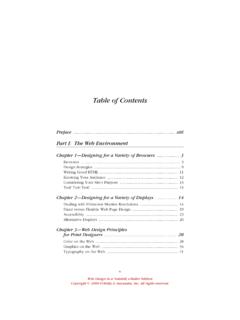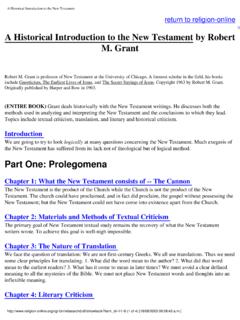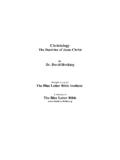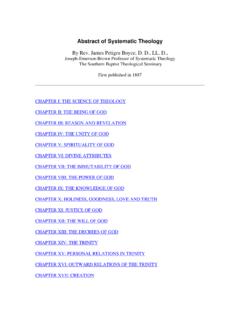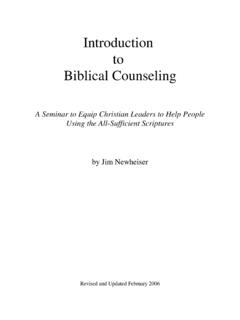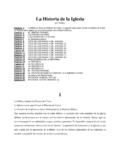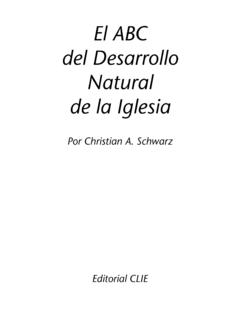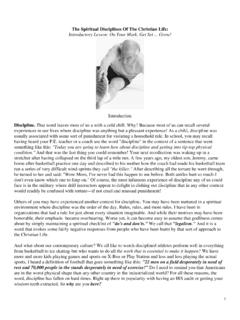Transcription of HOW WE GOT OUR BIBLE - Virtual Theological Resources
1 HOW WE GOT OUR BIBLE . by MIKE VLACH. August 1999. CONTENTS. Course Description 3. Introduction to How We Got the BIBLE 4. Revelation: God Has Spoken 5. Inspiration: The God-breathed Scriptures 8. Structure and Divisions of the BIBLE 11. The Making of the BIBLE 17. Canonicity: Determining and Discovering the God-inspired Books 20. Development of the Old Testament Canon 23. Old Testament Apocrypha and Pseudepigrapha 28. Development of the New Testament Canon 36. New Testament Antilegomena, Apocrypha and Pseudepigrapha 42. Texts and Manuscripts of the Old Testament 44. Texts and Manuscripts of the New Testament 47. Textual Criticism 51. History of the English BIBLE 53. Recommended Books 62. Bibliography 63. Course Description Purpose: Most Christians understand that the BIBLE they hold in their hands is the inspired Word of God.
2 Yet very few have a general understanding of the origin of the BIBLE . The purpose of this class, therefore, is to show the student how the BIBLE came to be and why it can be accepted as the unerring, authoritative Word of God. Issues covered: This eight-week course is devoted to the following issues: 1) Key terms relating to the BIBLE (Inspiration, Canonization, Transmission and Translation). 2) What the BIBLE was written on 3) Time period BIBLE was written in 4) Languages of the BIBLE 5) How the books of the BIBLE came to be recognized as Canon 6) Differences between the Hebrew, Protestant and Roman Catholic Bibles 7) The Apocryphal Books 8) Textual criticism 9) Old Testament manuscripts our BIBLE is based on 10) New Testament manuscripts our BIBLE is based on 11) Early translations of the BIBLE 12) The English BIBLE to 1611.
3 13) Recent English translations 14) Is the King James version the only version Christians should use? Course requirements: Everyone is welcome to attend all the classes even if they are not able to do the reading or the short projects. Also, one does not need to be a member of Indian Hills Community Church to attend. For those who wish to get the most out of this class the following is recommended: 1) Come to class and read the course handouts Our class sessions rely primarily on the course handouts. New handouts will be given out weekly. If you miss a week you can pick up back copies the next class period or pick up the notes from Room 104-105. 2) Read How We Got the BIBLE by Neil R. Lightfoot. You can purchase a copy from Sound Words. We will also have a copy of this book on reserve in the School of the Shepherd's Library.
4 3) Two take-home projects will be given out (probably around weeks 3 and 6). All the answers will be available in your class notes. Introduction to How We Got the BIBLE . a class on how we got our BIBLE ? be informed If we claim the BIBLE as the Word of God we should have a basic understanding of how it came to be. give a defense 1 Peter 3:15 states, but sanctify Christ as Lord in your hearts, always being ready to make a defense to everyone who asks you to give an account for the hope that is in you, yet with gentleness and reverence. Christians should be able to explain intelligently the basis of the Christian faith. This certainly would include our trust in the BIBLE . have greater assurance A study of how we got our BIBLE will give you greater assurance that the BIBLE you hold in your hand is accurate and truly represents what God originally gave to the prophets.
5 Four main links in the revelatory process The study of How We Got Our BIBLE can be summarized into four main sections Inspiration, Canonization, Transmission and Translation. The first link in the chain of revelation is inspiration. Inspiration deals with what God did, namely, breathing out the Scriptures. Inspiration is what gives the BIBLE its authority. The second link, canonization, deals with how the inspired books of God came to be recognized as Holy Scripture. Inspiration tells us how the BIBLE received its authority; canonization tells us how these books came to be accepted by men. The third link, transmission, deals with how the original autographs of the BIBLE were copied and whether these copies accurately reflect the original autographs.
6 The fourth link, translation, discusses the translation of the BIBLE into other languages and whether the BIBLE in our language accurately reflects what the Hebrew and Greek manuscripts said. Revelation: God Has Spoken The word revelation comes from the Greek word apokalupsis, which means disclosure or unveiling. Revelation has to do with disclosing, uncovering, or unveiling what previously was hidden, making known what had been secret. When used theologically.. revelation refers to God's deliberate manifestation of his plans, his character, and himself (William B. Nelson, Jr., Revelation, in The Oxford Companion To The BIBLE , p. 649.). of Revelation There are two avenues through which God has taken the initiative to reveal Himself General and Special revelation.
7 Revelation General revelation deals with the truths God has revealed about Himself to all mankind through nature, providential control, and conscience (Paul Enns. The Moody Handbook of Theology, p. 645). General revelation, though not adequate to procure salvation, reveals certain truths about God's nature to all humanity. God has revealed important truths about Himself and the guilt of man through nature. 19:1-6 The heavens are telling of the glory of God; and their expanse is declaring the work of His hands. Nature reveals God's glory and the facts that He exists. 1:18-21 For since the creation of the world His invisible attributes, His eternal power and divine nature, have been clearly seen, being understood through what has been made, so that they are without excuse.
8 Creation also shows that God is all-powerful and that the whole human race is guilty of sin and without excuse. God has revealed Himself through providential control. 5:45 God has graciously given people the sunshine and rain they need to function. 14:15-17 God has graciously provided food, rain and gladness for people. 2:21 God's control is seen through the raising up and removing of world rulers. God has given man an intuitional knowledge concerning Himself in the heart of man. According to Romans 2:14-15, every person has the Law of God written in their hearts thus knowing right from wrong. revelation Special revelation is narrower in focus than general revelation. Special revelation involves the various means God used to communicate His message.
9 By way of contrast, though general revelation is available to everyone, special revelation is available only to those who have access to biblical truth. Hebrews 1:1 tells us that God.. spoke long ago to the fathers in the prophets in many portions and in many ways. The avenues of special revelation God has used include: Lot The casting of lots sometimes communicated God's will to man (Proverbs 16:33; Acts 1:21-26). Urim and Thummim The Urim and Thummim were two precious stones on the breastplate of the high priest that were sometimes used to determine the will of God (Ex. 28:30; Num. 27:21; Deut. 33:8; 1 Sam. 28:6). God used dreams to communicate at various times in the Old Testament (Gen. 20:3; 31:11-13, 24; 40-41). Sometimes God used visions as He did with Isaiah and Ezekiel (Isa.)
10 1:1; 6:1;. and Ezek. 1:3). voice God sometimes spoke with an audible voice (1 Sam. 3:4; Luke 9:35). Before the incarnation of Christ, God sometimes manifested Himself, often as the Angel of the Lord, to communicate His divine message to the people (Gen. 16:7-14; Ex. 3:2; 2 Sam. 24:16; Zech. 1:12). Angels at times carried God's message to people (Dan. 9:20-21; Luke 2:10-11;. and Rev. 1:1). Prophets Old Testament and New Testament prophets received direct revelation and brought God's message to mankind (2 Sam. 23:2; Zech 1:1; and Eph. 3:5). and Events God used sign miracles and events such as the deliverance of Israel to reveal Himself. Christ God, after He spoke long ago to the fathers in the prophets in many portions and in many ways, in these last days has spoken to us in His Son (Heb.
